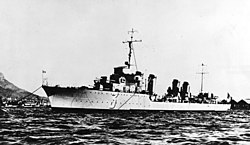Le Chevalier Paul (Ship, 1932)
|
Le Chevalier Paul (ca.1934)
|
||||||||||||||||||
|
||||||||||||||||||
|
||||||||||||||||||
|
||||||||||||||||||
|
||||||||||||||||||
The Le Chevalier Paul (named after Jean-Paul de Saumeur ) was a large destroyer ( French Contre-Torpilleurs) of the Vauquelin class of the French Navy . On June 15, 1941, the Le Chevalier Paul was sunk off the Syrian coast by a torpedo from a Fairey Swordfish of the 815 Naval Air Squadron.
Machine system
The drive system of Le Chevalier Paul consisted of four Penhoët boilers and two Parsons turbines . These drove the two screws via two drive shafts. The machines performed 64,000 WPS . This enabled a speed of 36 kn (about 67 km / h) to be achieved.
Armament
The main artillery of the Le Chevalier Paul consisted of five 13.86 cm L / 40 guns of the 1927 model in individual installation. This cannon could fire a 40.4 kilogram grenade over a maximum distance of 19,000 m. As anti-aircraft armament, the Le Chevalier Paul had four 3.7 cm anti-aircraft guns (L / 60) of the 1925 model in a single setup and four machine guns 13.2 mm / 76 Hotchkiss M1929 in a double setup. As torpedo armament, the destroyers had seven torpedo tubes in a group of three and two groups of two for the torpedo 23DT Toulon . For submarine hunts , the Le Chevalier Paul had two depth charges at the stern with a total of 36 depth charges and there was the possibility of holding up to 40 sea mines.
Whereabouts
On June 8, 1941, the Allies began Operation Exporter to occupy Lebanon and Syria. Admiral François Darlan commissioned the Le Chevalier Paul to bring ammunition for French ships to Beirut . The Germans and Italians were informed about the mission by radio and gave their consent. The British were able to decipher the message and were thus cleared up about the ship, purpose, time and route of the mission. The Le Chevalier Paul passed the Greek island of Kastelorizo on June 15, 1941 and stayed near the Turkish coast. At 6:15 p.m. she was spotted by a British reconnaissance plane. At 3:00 a.m. on June 16, 1941, six Fairey Swordfish of the 815 Naval Air Squadron attacked the ship and sank it by a torpedo hit. An attacking Swordfish was shot down. The Le Chevalier Paul sank about 90 kilometers off the Syrian coast to the approximate position 35 ° 20 ' N , 35 ° 20' O .
literature
- Roger Chesneau: Conway's All the World's Fighting Ships 1922-1946 . Conway Maritime Press, Greenwich 1980, ISBN 0-85177-146-7 .
- Vincent P. O'Hara: Struggle for the Middle Sea . Institute Press, New York 2013. ISBN 9781612514086 .
- Mike J. Whitley: Destroyer in World War II. Technology, classes, types . Motorbuchverlag, Stuttgart 1991, ISBN 3-613-01426-2 .
- John Jordan, Jean Moulin: French Destroyers: Torpilleurs d'Escadre & Contre-Torpilleurs 1922–1956 . Seaforth Publishing, Barnsley ISBN 978-1-84832-198-4 .
Web links
Footnotes
- ↑ 138.6 mm / 40 (5.46 ") Model 1927 gun data from navweaps.com. Accessed October 22, 2019. (English)
- ↑ 23 DT, Toulon torpedo data on navweaps.com. Retrieved October 22, 2019.
